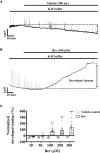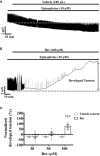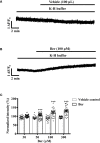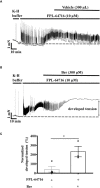Berberine Mediated Positive Inotropic Effects on Rat Hearts via a Ca2+-Dependent Mechanism
- PMID: 32581792
- PMCID: PMC7289965
- DOI: 10.3389/fphar.2020.00821
Berberine Mediated Positive Inotropic Effects on Rat Hearts via a Ca2+-Dependent Mechanism
Abstract
Previous studies showed that berberine, an alkaloid from Coptis Chinensis Franch, might exert a positive inotropic effect on the heart. However, the underlying mechanisms were unclear. Here, we reported that berberine at 10-20 µM increased the left ventricular (LV) developed pressure and the maximal rate of the pressure rising, and it increased the maximal rate of the pressure descending at 20 µM in Langendorff-perfused isolated rat hearts. These effects diminished with the concentration of berberine increasing to 50 µM. In the concentration range of 50-300 µM, berberine increased the isometric tension of isolated left ventricular muscle (LVM) strips with or without electrical stimulations, and it (30-300 µM) also increased the intracellular Ca2+ level in the isolated LV myocytes. The removal of extracellular Ca2+ hindered the berberine-induced increases in the tension of LVM strips and the intracellular Ca2+ level of LV myocytes. These suggested that berberine might exert its positive inotropic effects via enhancing Ca2+ influx. The blockade of L-type Ca2+ channels (LTCCs) with nifedipine significantly attenuated 300 μM berberine-induced tension increase in LVM strips but not the increase in the intracellular Ca2+ level. Berberine (300 μM) further increased the LVM tension following the treatment with the LTCC opener FPL-64716 (10 μM), indicating an LTCC-independent effect of berberine. Lowering extracellular Na+ attenuated the berberine-induced increases in both the tension of LVM strips and the intracellular Ca2+ level of LV myocytes. In conclusion, berberine might exert a positive inotropic effect on the isolated rat heart by enhancing the Ca2+ influx in LV myocytes; these were extracellular Na+-dependent.
Keywords: Ca2+; Na+; berberine; heart; positive inotropic effect.
Copyright © 2020 Zhao, Wang, Gao, Jing and Xin.
Figures












Similar articles
-
Ranolazine improves diastolic dysfunction in isolated myocardium from failing human hearts--role of late sodium current and intracellular ion accumulation.J Mol Cell Cardiol. 2008 Jul;45(1):32-43. doi: 10.1016/j.yjmcc.2008.03.006. Epub 2008 Mar 14. J Mol Cell Cardiol. 2008. PMID: 18439620
-
Dofetilide enhances the contractility of rat ventricular myocytes via augmentation of Na+-Ca 2+ exchange.Cardiovasc Drugs Ther. 2009 Jun;23(3):207-14. doi: 10.1007/s10557-009-6163-x. Epub 2009 Feb 17. Cardiovasc Drugs Ther. 2009. PMID: 19221884
-
[Negative inotropic effect of meperidine in rat ventricular muscle and the underlying mechanism].Sheng Li Xue Bao. 2003 Apr 25;55(2):197-200. Sheng Li Xue Bao. 2003. PMID: 12715111 Chinese.
-
Mechanisms of inotropic responses of the isolated rat hearts to vanadate.Int J Cardiol. 1995 Nov 24;52(2):101-13. doi: 10.1016/0167-5273(95)02457-8. Int J Cardiol. 1995. PMID: 8749869
-
Positive inotropic, positive chronotropic and coronary vasodilatory effects of rat amylin: mechanisms of amylin-induced positive inotropy.Acta Physiol Hung. 2010 Dec;97(4):362-74. doi: 10.1556/APhysiol.97.2010.4.2. Acta Physiol Hung. 2010. PMID: 21138812
Cited by
-
Integrating Evidence of the Traditional Chinese Medicine Collateral Disease Theory in Prevention and Treatment of Cardiovascular Continuum.Front Pharmacol. 2022 Mar 15;13:867521. doi: 10.3389/fphar.2022.867521. eCollection 2022. Front Pharmacol. 2022. PMID: 35370696 Free PMC article. Review.
-
Non-coding RNAs: targets for Chinese herbal medicine in treating myocardial fibrosis.Front Pharmacol. 2024 Feb 27;15:1337623. doi: 10.3389/fphar.2024.1337623. eCollection 2024. Front Pharmacol. 2024. PMID: 38476331 Free PMC article. Review.
-
New Thiazole Acetic Acid Derivatives: A Study to Screen Cardiovascular Activity Using Isolated Rat Hearts and Blood Vessels.Molecules. 2022 Sep 20;27(19):6138. doi: 10.3390/molecules27196138. Molecules. 2022. PMID: 36234675 Free PMC article.
-
Chenodeoxycholic and deoxycholic acids induced positive inotropic and negative chronotropic effects on rat heart.Naunyn Schmiedebergs Arch Pharmacol. 2021 Apr;394(4):765-773. doi: 10.1007/s00210-020-01962-7. Epub 2020 Aug 18. Naunyn Schmiedebergs Arch Pharmacol. 2021. PMID: 32808070
-
Inhibition of Contractility of Isolated Caprine Detrusor by the Calcium Channel Blocker Cilnidipine and Reversal by Calcium Channel Openers.Curr Ther Res Clin Exp. 2023 Sep 30;99:100717. doi: 10.1016/j.curtheres.2023.100717. eCollection 2023. Curr Ther Res Clin Exp. 2023. PMID: 37869401 Free PMC article.
References
LinkOut - more resources
Full Text Sources
Miscellaneous

